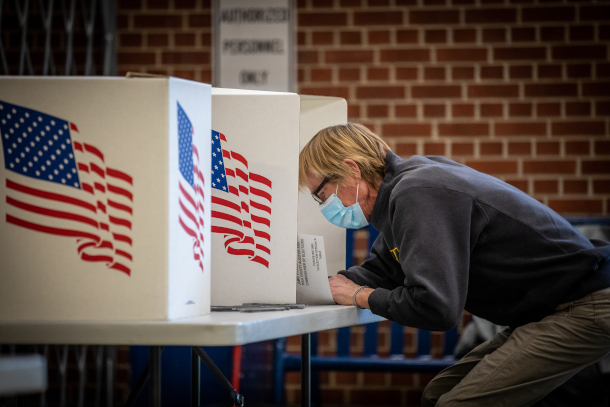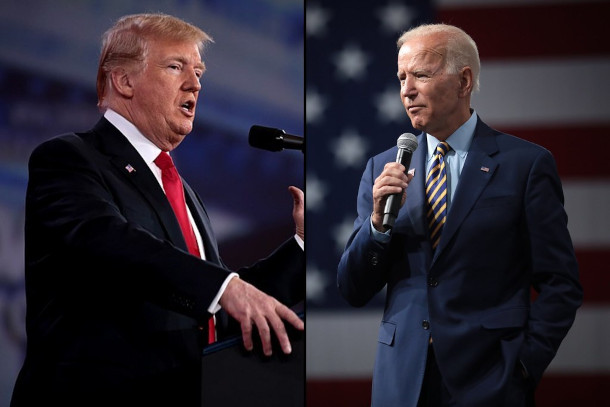Climate Voter Power
Air Date: Week of July 19, 2024

A study from the University of Colorado Boulder analyzed voting trends and used predictive modeling to conclude that climate-focused voter turnout played a pivotal role in electing Joe Biden in 2020. (Photo: Phil Roeder, Flickr, CC BY 2.0)
Climate may not always top the list of voter concerns, but research suggests it can tip the scales in US presidential elections, including the 2020 election which came down to 44,000 votes. So the Environmental Voter Project is trying to mobilize nearly 5 million registered voters who rate environment or climate as a top concern but might not otherwise turn out this November. Nathaniel Stinnett is its founder and director and joined Living on Earth’s Aynsley O’Neill to explain why this latent voting bloc is worth tapping into.
Transcript
CURWOOD: It’s Living on Earth, I’m Steve Curwood
DOERING: And I’m Jenni Doering.
Climate may not always top the list of voter concerns, but compelling research suggests it can tip the scales in US presidential elections.
And researchers say that environment focused voters were an essential part of the winning margin for Joe Biden’s 2020 bid for the White House.
Their surveys also found that a quarter of Republicans who see climate change as “very important” went for Biden in that election.
And their numbers show that if levels of concern about the climate had remained stagnant from polling in 2016, Donald Trump would have likely won re-election in 2020.
CURWOOD: And Jenni, the numbers of climate focused voters today may still be small compared to other constituencies, but when elections are very close every vote does make a difference.
And of course the climate emergency is only getting worse.
And that is why the Environmental Voter Project is trying to mobilize nearly 5 million environment-first voters they have identified through polling who might not otherwise turn out.
So, Living on Earth’s Aynsley O’Neill spoke with founder and executive director Nathaniel Stinnett.
Let’s take a listen.
STINNETT: Remember, the 2020 presidential election was so close that it was decided by just 44,000 people in three states: Wisconsin, Arizona, and Georgia. 44,000 voters decided the 2020 presidential election. And so there are a whole bunch of issue constituency groups who could have had an impact. But for climate voters in particular, a recent University of Colorado Boulder study of polls and voter files and predictive models, not just in those three states, but also in other important battleground states showed that the increase in climate concerned voters from 2016 to 2020, so new climate voters in that 2020 election, had a large enough impact that it delivered the White House to Joe Biden. So climate voters didn't just have an impact in 2020, there's good reason to believe that they literally decided the election, at least for the White House.
O'NEILL: Well, so let's paint a picture of an environment first voter, how does the EVP define that?
STINNETT: We define it as people who are already registered to vote, and they either list climate change as their number one priority, Or they list clean air, clean water, and the environment as their number one priority. So these are people who don't just care about environmental issues, it is their top priority.
O'NEILL: When many people picture somebody who cares about the environment, they might be thinking, young, liberal person, large metal water bottle and driving a Prius. How accurate is that representation of an environment-first voter?
STINNETT: So it's not inaccurate, but there's a lot more nuance than people might otherwise think. So yes, environment-first voters are disproportionately young, and they are disproportionately progressive. But what some people might not know is that the second largest age group of environment-first voters, is people aged 65 and up. So we need to start thinking of the climate movement, and the environmental movement as not just being young hipsters, but also being grandmothers and grandfathers because it's increasingly, a movement made up of 20 year olds and 60 year olds and 70 year olds.
O'NEILL: Now, Nathaniel, when politicians in Washington, DC talk about environment, they don't always lump together clean air, clean water, and climate action. So why does the Environmental Voter Project do that when they define an environment-first voter?

This year’s presidential election could be decided by environment-first voters in swing states. (Photo: Original photos by Gage Skidmore. Adapted and republished by Emma Kaden. Flickr, CC BY-SA 2.0)
STINNETT: Well, for two reasons. One is just logistically speaking, we need to try to isolate a group of people who we can define and then mobilize to vote. And it's always easier to do that, if you're not parsing it down by particular sub-issues, or particular policy proposals. But the second reason is, we at the Environmental Voter Project care about all of those sub-issues. We care about the climate crisis, we care about cleaning up toxic air and toxic water. We care about the environment. And we firmly believe that if we dramatically increase the number of voters who care about those issues, then politicians will respond. And yes, each policy proposal presents a different set of issues. And oftentimes politicians will think one way or the other. But the one thing we're confident of is nothing motivates a politician more than the prospect of winning or losing an election. So no matter what environmental policy they are presented with, if there are more and more environmental voters in their district, each year, these politicians will be more likely to lead on clean air, to lead on clean water, and to lead on the climate crisis, because we've created this voter demand for it in their district.
O'NEILL: And when you take a look at both climate, but then also clean air, clean water, do you have any numbers on how those different proportions play out?
STINNETT: So the reason we try to catch both of those sort of subgroups of environmentalists, is because we often expect there to not be perfect overlap. We expect there to be big differences or at least measurable differences between people who care deeply about the climate crisis, as opposed to people who care deeply about other environmental issues. But there isn't that much of a difference. Every time we measure this, we find that people who care about one environmental issue tend to also care deeply about other environmental issues. And the numbers have been pretty steadily going up. We have found that across the United States, roughly 8% or 9% of registered voters are likely to list climate or other environmental issues as their top priority, and that aligns with most public polling that we're seeing.
O'NEILL: But Nathaniel, I've seen the statistic that according to the Pew Research Center, protecting the environment doesn't even make the top 10 priorities of American voters in 2024. So why do environment-first voters matter?
STINNETT: Well, first off, let's just say it's true that there are far, far too few climate-first and environment-first voters. And that lack of political power is much of the reason why politicians rarely lead on climate. Because when there are too few voters who prioritize climate, politicians don't feel the need to address it. But to get to your question, the reason it's important still, is because there are millions of non-voters who do care deeply about climate and environment. And they could make a huge difference if they show up on election day. But that if is a really, really big, underlined, bold IF, because climate first and environment first voters don't always show up.

Stinnett argues that, regardless of a candidate’s political party, they care about getting votes. By mobilizing environment-first voters, he hopes to make the environment less of a partisan issue. (Photo: Courtesy of Nathaniel Stinnett)
O'NEILL: In that case, to what extent do you think they might determine the outcome of this upcoming election?
STINNETT: So at the Environmental Voter Project, we work in 19 states, and we've identified 4.8 million already-registered environment-first voters who are unlikely to vote this fall, unless they get mobilized to do so. But that's a huge number, especially when you consider that only 44,000 voters decided the last presidential election. So the climate movement has a lot of potential electoral power pent up here. It's just a question of whether it will be actualized. Now as far as could they make a difference? Oh, my gosh, absolutely. I mean, let's just look at two of the most important swing states. In Pennsylvania, a state that was decided by 80,000 votes in 2020. The Environmental Voter Project has identified 250,000 of these low-propensity environment-first voters. Another example in Nevada, another crucial swing state that was decided by just 33,000 votes four years ago, we've identified 110,000 of these low-propensity climate voters So in short, if climate voters show up, they can absolutely decide the 2024 election.
O'NEILL: Nathaniel Stinnett, founder and executive director of the Environmental Voter Project, speaking with Living on Earth’s Aynsley O’Neill.
Links
Learn more about the Environmental Voter Project
Research indicates that climate-first voters may have decided the 2020 presidential election.
Follow our partner, Inside Climate News,’ coverage of the 2024 election season.
Living on Earth wants to hear from you!
Living on Earth
62 Calef Highway, Suite 212
Lee, NH 03861
Telephone: 617-287-4121
E-mail: comments@loe.org
Newsletter [Click here]
Donate to Living on Earth!
Living on Earth is an independent media program and relies entirely on contributions from listeners and institutions supporting public service. Please donate now to preserve an independent environmental voice.
NewsletterLiving on Earth offers a weekly delivery of the show's rundown to your mailbox. Sign up for our newsletter today!
 Sailors For The Sea: Be the change you want to sea.
Sailors For The Sea: Be the change you want to sea.
 The Grantham Foundation for the Protection of the Environment: Committed to protecting and improving the health of the global environment.
The Grantham Foundation for the Protection of the Environment: Committed to protecting and improving the health of the global environment.
 Contribute to Living on Earth and receive, as our gift to you, an archival print of one of Mark Seth Lender's extraordinary wildlife photographs. Follow the link to see Mark's current collection of photographs.
Contribute to Living on Earth and receive, as our gift to you, an archival print of one of Mark Seth Lender's extraordinary wildlife photographs. Follow the link to see Mark's current collection of photographs.
 Buy a signed copy of Mark Seth Lender's book Smeagull the Seagull & support Living on Earth
Buy a signed copy of Mark Seth Lender's book Smeagull the Seagull & support Living on Earth

